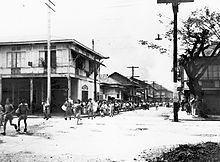| Manila massacre | |
|---|---|
| Part of World War II | |
 Photo of a Filipino woman and child killed by Japanese forces in Manila | |
| Location | Manila, Philippines |
| Date | 3 February – 3 March 1945 (EDT) |
| Target | Filipinos |
Attack type | Mass murder, massacre |
| Deaths | 100,000–500,000[1][2] |
| Perpetrators | Tomoyuki Yamashita, Akira Mutō, Sanji Iwabuchi Imperial Japanese Army |
| Motive | Japanese nationalism, Anti-Filipino sentiment |
| Part of a series on |
| Statism in Shōwa Japan |
|---|
 |


The Manila massacre (Filipino: Pagpatay sa Maynila or Masaker sa Maynila), also called the Rape of Manila (Filipino: Paggahasa ng Maynila), involved atrocities committed against Filipino civilians in the City of Manila, the capital of the Philippines, by Japanese troops during the Battle of Manila (3 February 1945 – 3 March 1945) which occurred during World War II. At least 100,000 civilians were killed in total during the battle from all causes, including the massacre by Japanese troops.
The Manila massacre was one of several major war crimes committed by the Imperial Japanese Army, as judged by the postwar military tribunal. The Japanese commanding general, Tomoyuki Yamashita, and his chief of staff Akira Mutō, were held responsible for the massacre and other war crimes in a trial which started in October 1945. Yamashita was executed on 23 February 1946 and Mutō on 23 December 1948.[3]
- ^ Cite error: The named reference
Connaughtonwas invoked but never defined (see the help page). - ^ Cite error: The named reference
Tomwas invoked but never defined (see the help page). - ^ "Gen. Akira Mutō". The International Military Tribunal For The Far East: Digital Collection. University of Virginia School of Law. Retrieved 24 June 2021.